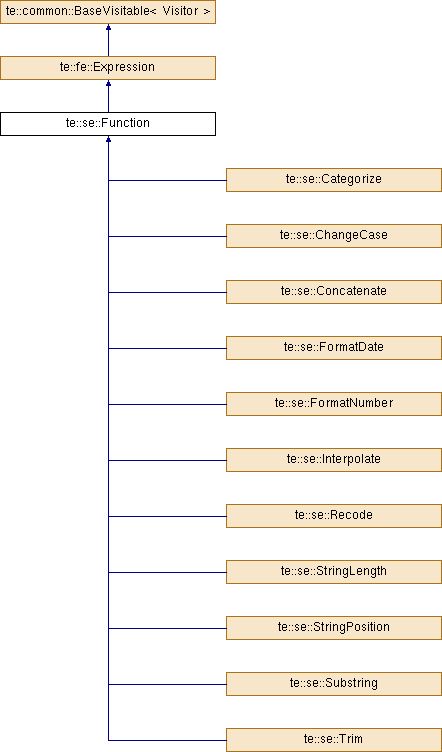Symbology Encoding functions. More...
#include <Function.h>

Public Types | |
| typedef void | ReturnType |
| typedef Visitor | VisitorType |
Public Member Functions | |
| virtual ReturnType | accept (VisitorType &guest) const =0 |
| It call the visit method from the guest object. More... | |
| virtual Expression * | clone () const =0 |
| It returns a clone of this object. More... | |
| const std::string & | getFallbackValue () const |
| void | setFallbackValue (const std::string &v) |
Initializer Methods | |
Methods related to instantiation and destruction. | |
| Function () | |
| It initializes a new Function. More... | |
| virtual | ~Function () |
| Virtual destructor. More... | |
Protected Attributes | |
| std::string | m_fallbackValue |
| The value of the fallbackValue attribute is used as a default value, if the SE implementation does not support the function. If the implementation supports the function, then the result value is determined by executing the function. (Mandatory) More... | |
Symbology Encoding functions.
Symbology Encoding extends the concept of ogc::fe::Expression inherited from Filter Encoding to adequately support the needs of symbolization in transforming and editing data. It does so by introducing a couple of functions (ogc::se::Function) which are substitutable for ogc::fe::expression.
There are two general groups of functions for usage in SE. The first group is used to transform raw values into "symbolizable" quantities. This especially comprises the processes of categorization, recoding, and interpolation. This group of functions is especially useful in all places using SvgParameters, making them dynamically related to data values. The second group defines means for formatting data items like numbers, strings, and dates. These functions are especially helpful to set up the Label element of TextSymbolizers.
Definition at line 65 of file Function.h.
|
inherited |
Definition at line 58 of file BaseVisitable.h.
|
inherited |
Definition at line 57 of file BaseVisitable.h.
| te::se::Function::Function | ( | ) |
It initializes a new Function.
|
virtual |
Virtual destructor.
|
pure virtualinherited |
It call the visit method from the guest object.
| guest | The guest or visitor. |
|
pure virtualinherited |
It returns a clone of this object.
Implemented in te::fe::BinaryOperator, te::fe::Function, te::se::Interpolate, te::se::Categorize, te::fe::Literal, te::fe::PropertyName, te::se::Recode, te::se::InterpolationPoint, and te::se::MapItem.
| const std::string& te::se::Function::getFallbackValue | ( | ) | const |
| void te::se::Function::setFallbackValue | ( | const std::string & | v | ) |
|
protected |
The value of the fallbackValue attribute is used as a default value, if the SE implementation does not support the function. If the implementation supports the function, then the result value is determined by executing the function. (Mandatory)
Definition at line 88 of file Function.h.